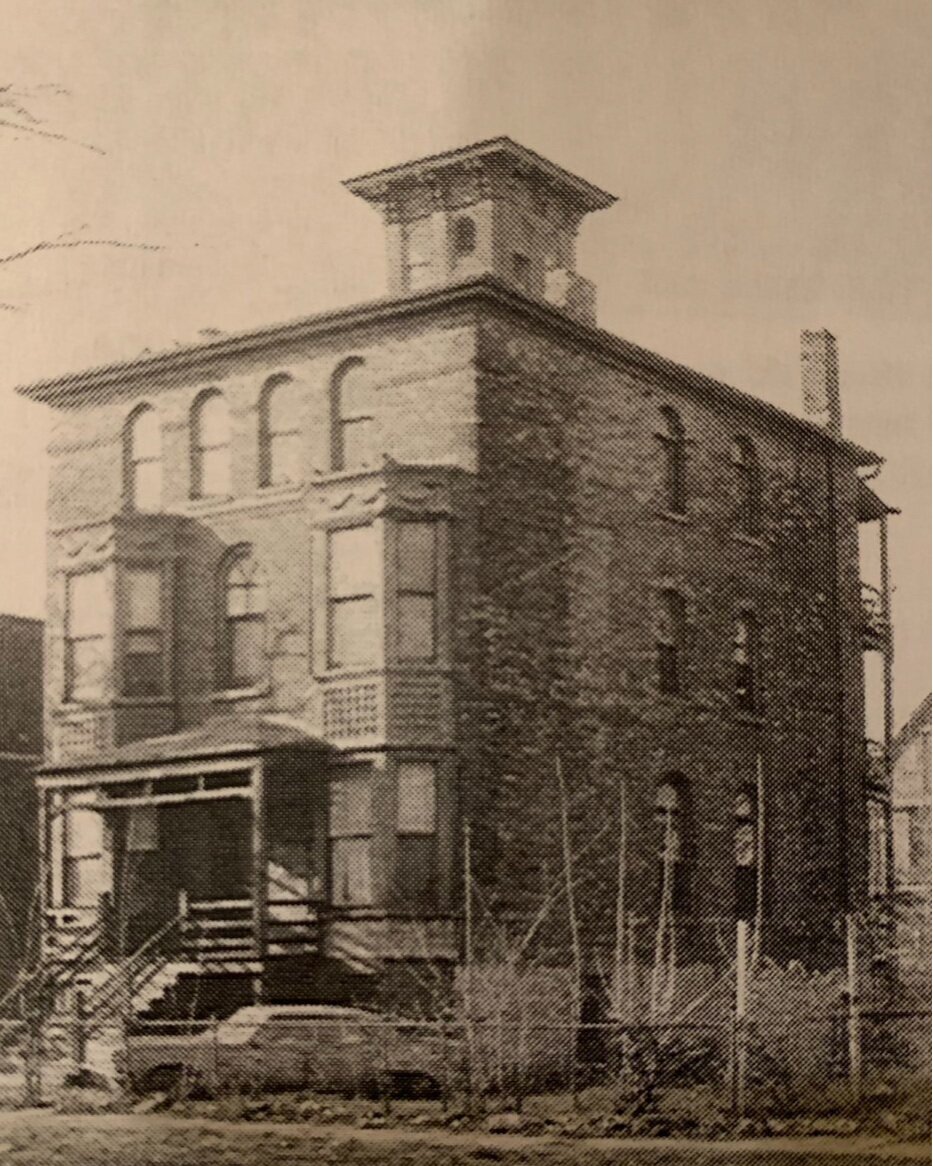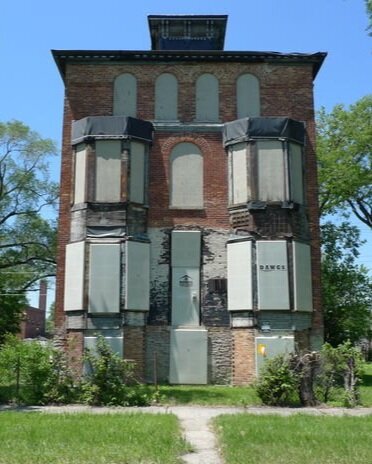Introducing the Civic Arts Church
2021 | Redefining Historic Preservation at The Common|wealth







In early 2020, Sweet Water Foundation (SWF) acquired an abandoned church at 5810 S. Lafayette Avenue, just a stone's throw from the heart of The Common|Wealth. The church was once an anchor in the neighborhood and securing the building and its adjacent lots was critical given the precarity of the local real estate market. Far too often, such buildings are left neglected and vacant for years, becoming “zombie properties” that compromise both the safety and the future of the neighborhood. The SWF team immediately began envisioning how the building might be renovated and activated into a place that honors and preserves histories that have been erased and untold. SWF shared its vision with the National Trust for Historic Preservation and, in July 2020, was awarded an African American Cultural Heritage Action Fund grant to reimagine and revitalize the church and other spaces across The Common|Wealth.
In 2021, Sweet Water Foundation will transform the church into a community design center known as Civic Arts Church.
SWF is undertaking a collaborative, contextualized, and regenerative approach to historic preservation that will amplify the rich African American heritage of the community and offer guidance to a more radical and imaginative collective future. In collaboration with the National Trust for Historic Preservation, Landmark Illinois, and Values-Based Partners, SWF will demonstrate how cultural preservation, neighborhood development, and reconciliatory practices can not only coexist, but also be intentionally woven into the urban fabric of present day realities.
Read on to learn more about the past, present, and future of Civic Arts Church.
Challenging the Traditional Lens of Historic Preservation
Towards what end should history be preserved? Who decides which aspects of history are to be preserved, how are they to be preserved, and what is to be forgotten? For structures that achieve historic landmark status, which elements of their history are deemed worthy to be told through the preservation of their exterior shell and what considerations are to be given to their present day context? If the built environment represents a growing library describing the morphology and evolution of the city’s form and offers a glimpse into the socio-political context over time, who decides which authors and narratives shall be shared?
The Common|Wealth lies within the epicenter of Chicago’s histories of the Great Migration, urban renewal, redlining, white flight, and disinvestment. However, local historic preservation efforts focus solely on the Raber House, an Italianate-style brick residence from 1870, constructed as a private residence on an island of 10 acres of land to itself. The Raber House offers a singular reductive and colonial historical narrative that lacks any connection to its present day context. Yet, it has been highlighted as the one and only promise of utopian development, somehow capable of resurrecting a neighborhood that has otherwise been deemed undesirable and ill-suited to be amidst its glory.
Despite receiving designation as a Chicago Landmark on April 16, 1996, the brick vessel is now a boarded-up empty shell of its former self, frozen in a state of disrepair and desperately seeking to find meaning and justify its existence in the 21st century. In every sense, the Raber House represents the unshakable hypocrisy of authorship by a chosen few who select which aspects of culture or heritage are worthy of preserving and celebrating. The stark reality is that the building has been abandoned for decades and, had it not been favored by the traditional lens of historical preservation, would otherwise be labeled a “zombie property” with no foreseeable plans for redevelopment and, ultimately, destined for demolition.
Historic Preservation Through a Regenerative Lens
Since 2014, SWF has offered urban acupuncture-like interventions that actively re-story and re-construct a neighborhood located at the nexus of Englewood and Washington Park, two African American communities that have endured decades of disinvestment. SWF’s work is a direct response to the everyday chaos of economic hardships, violence, perpetual poverty, and systemic racism that pervades these communities. Despite the transformation of The Common|Wealth, the surrounding area remains scarred by redlining and other racist and degenerative policies and practices that have created an ecology of absence.
Families across the South Side of Chicago are descendants of black folks of the Great Migration with ancestors who attended negro school houses in Mississippi, Arkansas, and Alabama. The Negro Rural School, itself, was conceived when Booker T. Washington and Julius Rosenwald first met at a luncheon in Chicago in 1911. Known as The Rosenwald Schools, the Negro Rural School outlined a vision for an 8-acre site with housing, farming, and vocation/trades-based education. More than 100 years later, The Common|Wealth is the manifestation of this vision.
Rather than following traditional methods of development and preservation, SWF is undertaking a collaborative, contextualized, and regenerative approach that will amplify the rich African American heritage of the community and offer guidance to a more radical and imaginative collective future. SWF’s approach will widen the discourse to embrace how the practices of cultural preservation, neighborhood development, and reconciliatory practices can not only coexist, but also be intentionally woven into the urban fabric of the present day realities. The act of preserving and transforming the church at 5810 S. Lafayette into Civic Arts Church will unveil elements of Black History in Chicago that are untold and will reactivate a community asset that is deeply rooted in the history of the people who live in the neighborhood today.
History of the Church at 5810 S. Lafayette Avenue
It is precisely because the lens of historical preservation in the neighborhood has focused solely on the Raber House that so little is known about this history of the church at 5810 S. Lafayette Avenue. What is known, is that it is a historically black church. Public records show that for the last thirty years, the church housed Mount Moriah Missionary Baptist Church and Deliverance Healing Temple. The Sweet Water Foundation team has also collected oral histories from current and former neighborhood residents about the church’s stature as a place of fellowship and healing.
In 2021, as part of its efforts to transform the church into Civic Arts Church, Sweet Water Foundation and its partners will conduct research to piece together the history of the building and its relation to the neighborhood and its people.
“The black church has been a hub of spirituality... and a sanctuary of actual physical safety. Unfortunately, social issues were too much for the institution to overcome. The residents and parishioners did try and this building is evidence of that. The different modifications and add-ons illustrate attempts by the community to maintain and upgrade, despite limited resources and uphill battles.”
Historical Sanborn maps show us that the neighborhood in which The Common|Wealth lies was once densely packed with family homes, businesses, and the church at 5810 S. Lafayette Avenue. Today, the area depicted on the maps above reflects a rural population density with 79% of the parcels sitting vacant. The prescriptive pathology of redlining and other racist and degenerative policies and practices have created an ecology of absence that is seen all throughout Chicago’s South and West Sides and in similar communities across the nation.
Despite nearly a century of institutional, systemic, and individual racist practices that denied generations of black Chicago families access to the “American Dream,” the church still remains. In the words of SWF Core Team Member, Micheal Reynolds, Sweet Water Foundation’s transformation of the church at 5810 S. Lafayette Avenue into Civic Arts Church will signal “something new arising … , a message of hope.”
The Vision | Civic Arts Church
In 2021, the church at 5810 S. Lafayette Avenue will become Civic Arts Church, a beacon of community design. With regenerative artistic practice at its core, the Civic Arts Church will stand as a demonstration of how cultural preservation, neighborhood development, and reconciliatory practices can not only coexist, but also be intentionally woven into the urban fabric of present day realities.
Programming at Civic Arts Church
Sweet Water Foundation and its Values-Based Partners will program nearly every inch of the ~2,750 square foot building and the adjacent land. Civic Arts Church will attract and engage artists, craftspeople, local residents, and youth in design and Regenerative Arts practice. Civic Arts Church will also be a central gathering and gallery space for workshops, field lessons, and events at The Common|Wealth. An overview of future programming is detailed below.
The Nave. Situated on the main floor, The Nave will become the central gathering space within Civic Arts Church, providing ~1,800 square feet of open programming space that culminates with a performance stage at the west end. Here, an intergenerational and international audience will congregate to experience and practice Regenerative Arts that span dance, music, printmaking, and more.
The Furnace. On the lower level, The Furnace will be home to Sweet Water Foundation’s community printmaking and textile arts studio. Humans-in-Residence, Sweet Water Academy Apprentices + Fellows, and visitors, alike, will engage in practices such as block printing, carving, weaving, macrame, and more. The Furnace will also have a lounge space, dressing room, restrooms, and storage.
The Path Forward...
Sweet Water Foundation shared its vision with the National Trust for Historic Preservation and, in July 2020, was awarded an African American Cultural Heritage Action Fund grant to reimagine and revitalize the church and other spaces across The Common|Wealth. Equipped with this support, the SWF Team began initial activation of the church in Fall 2020 with arts + culture programming and carpentry workshops with SWF’s Fall 2020 Global Fellows. Sweet Water Foundation also launched a flexible and inclusive visioning, research, and design process for Civic Arts Church that is engaging local residents, stakeholders, historians & preservationists, subject matter experts, elected officials, potential investors, and other partners.
In early 2021, a detailed plan for the Initial Phase of [Re]construction of the church will be finalized and Sweet Water Foundation will launch a campaign to raise funds to bring Civic Arts Church to life. A structural assessment has determined that, although the building has a strong foundation, significant roof work is required in addition to much-needed interior renovations. The Initial Phase of [Re]construction will address baseline structural, roof, and interior renovations, as well as develop preliminary plans for future interior and exterior renovations. SWF hopes to complete the Initial Phase by June 2021.







